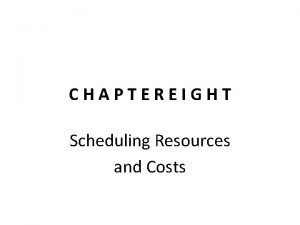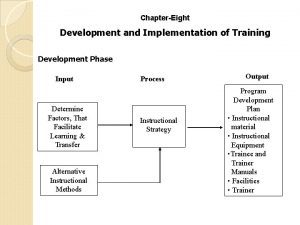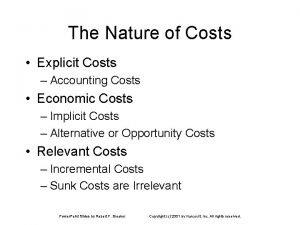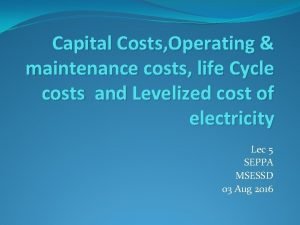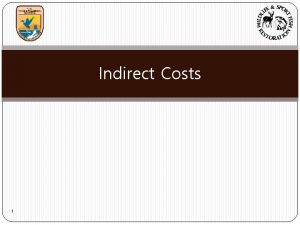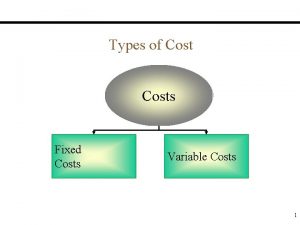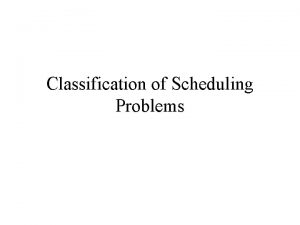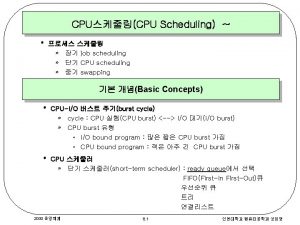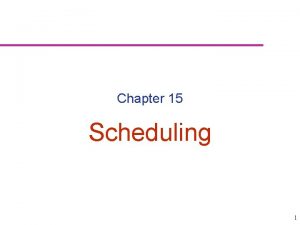CHAPTEREIGHT Scheduling Resources and Costs Overview of the
















- Slides: 16

CHAPTEREIGHT Scheduling Resources and Costs

Overview of the Resource Scheduling Problem After staff and other resources were assigned to her project, a project manager listed the following questions that still needed to be addressed: o Will the assigned labor and/or equipment be adequate and available to deal o with my project? o Will outside contractors have to be used? o Do unforeseen resource dependencies exist? Is there a new critical path? o How much flexibility do we have in using resources? o Is the original deadline realistic?

Types of Resource Constraints 1. People. This is the most obvious and important project resource. Human resources are usually classified by the skills they bring to the project—for example programmer, mechanical engineer, welder, inspector, marketing director, supervisor. In rare cases some skills are interchangeable, but usually with a loss of productivity. The many differing skills of human resources add to the complexity of scheduling projects. 2. Materials. Project materials cover a large spectrum: for example, chemicals for a scientific project, concrete for a road project, survey data for a marketing project. 3. Equipment is usually presented by type, size, and quantity. In some cases equipment can be interchanged to improve schedules, but this is not typical. Equipment is often overlooked as a constraint. The most common oversight is to assume the resource pool is more than adequate for the project. For example, if a project needs one earthmoving tractor six months from now and the organization owns four, it is common to assume the resource will not delay the pending project.

Classification of a Scheduling Problem • A time-constrained project is one that must be completed by an imposed date. If required, resources can be added to ensure the project is completed by a specific date. Although time is the critical factor, resource usage should be no more than is necessary and sufficient. • A resource-constrained project is one that assumes the level of resources available cannot be exceeded. If the resources are inadequate, it will be acceptable to delay the project, but as little as possible.

Resource Allocation Methods • Assumptions • First, splitting activities will not be allowed. This means once an activity is placed in the schedule, assume it will be worked on continuously until it is finished; hence, an activity cannot be started, stopped for a period of time, and then finished. • Second, the level of resources used for an activity cannot be changed. These limiting assumptions do not exist in practice, but simplify learning. It is easy for new project managers to deal with the reality of splitting activities and changing the level of resources when they meet them on the job.

Time-Constrained Projects: Smoothing Resource Demand Scheduling timeconstrained projects focuses on resource utilization. When demand for a specific resource type is erratic, it is difficult to manage, and utilization may be very poor. Practitioners have attacked the utilization problem using resource leveling techniques that balance demand for a resource. • Resource-Constrained Projects When the number of people and/or equipment is not adequate to meet peak demand requirements and it is impossible to obtain more, the project manager faces a resource-constrained problem.

The parallel method is the most widely used approach to apply heuristics, which have been found to consistently minimize project delay over a large variety of projects. The parallel method is an iterative process that starts from the beginning of project time and, when resources needed exceed the resources available, retains activities first by the priority rules: • 1. Minimum slack. • 2. Smallest duration. • 3. Lowest activity identification number.

Splitting Activities • Splitting tasks is a scheduling technique used to get a better project schedule and/or to increase resource utilization. • A planner splits the continuous work included in an activity by interrupting the work and sending the resource to another activity for a period of time and then having the resource resume work on the original activity. • Splitting can be a useful tool if the work involved does not include large start-up or shutdown costs—for example, moving equipment from one activity location to another. • The most common error is to interrupt “people work, ” where there are high conceptual start-up and shutdown costs. • For example, having a bridge designer take time off to work on the design problem of another project may cause this individual to lose four days shifting conceptual gears in and out of two activities. The cost may be hidden, but it is real.

Splitting Activities

Benefits of Scheduling Resources • It is important to remember that, if resources are truly limited and activity time estimates are accurate, the resource-constrained schedule will materialize as the project is implemented—not the time-constrained schedule! • Therefore, failure to schedule limited resources can lead to serious problems for a project manager. The benefit of creating this schedule before the project begins leaves time for considering reasonable alternatives. • If the scheduled delay is unacceptable or the risk of being delayed too high, the assumption of being resource constrained can be reassessed. Cost-time trade-offs can be considered. In some cases priorities may be changed.

Multiproject Resource Schedules The following lists three of the more common problems encountered in managing multiproject resource schedules. Note that these are macro manifestations of single-project problems that are now magnified in a multiproject environment: 1. Overall schedule slippage. Because projects often share resources, delays in one project can have a ripple effect and delay other projects. For example, work on one software development project can grind to a halt because the coders scheduled for the next critical task are late in completing their work on another development project. 2. Inefficient resource utilization. Because projects have different schedules and requirements, there are peaks and valleys in overall resource demands. For example, a firm may have a staff of 10 electricians to meet peak demands when, under normal conditions, only 5 electricians are required. 3. Resource bottlenecks. Delays and schedules are extended as a result of shortages of critical resources that are required by multiple projects. For example, at one Lattice Semiconductor facility, project schedules were delayed because of competition over access to test equipment necessary to debug programs. Likewise, several projects at a U. S. forest area were extended because there was only one silviculturist on the staff.

Using the Resource Schedule to Develop a Project Cost Baseline Why a Time-Phased Budget Baseline Is Needed The need for a time-phased budget baseline is demonstrated in the following scenario. • The development of a new product is to be completed in 10 weeks at an estimated cost of $400, 000 per week for a total cost of $4 million. Management wants a status report at the end of five weeks. The following information has been collected: • Planned costs for the first five weeks are $2, 000. • Actual costs for the first five weeks are $2, 400, 000 How are we doing? It would be easy to draw the conclusion there is a $400, 000 cost overrun. But we really have no way of knowing. The $400, 000 may represent money spent to move the project ahead of schedule. Assume another set of data at the end of five weeks: • Planned costs for the first five weeks are $2, 000. • Actual costs for the first five weeks are $1, 700, 000. • •

Creating a Time-Phased Budget 1. Define work (what). 2. Identify time to complete a work package (how long). 3. Identify a time-phased budget to complete a work package (cost). 4. Identify resources needed to complete a work package (how much). 5. Identify a single person responsible for units of work (who). 6. Identify monitoring points for measuring progress (how well).



 Scheduling resources and costs
Scheduling resources and costs Scheduling resources and costs
Scheduling resources and costs Sjn scheduling
Sjn scheduling Transformation process
Transformation process Fixed resources and variable resources
Fixed resources and variable resources Renewable resources vs nonrenewable resources
Renewable resources vs nonrenewable resources Hình ảnh bộ gõ cơ thể búng tay
Hình ảnh bộ gõ cơ thể búng tay Slidetodoc
Slidetodoc Bổ thể
Bổ thể Tỉ lệ cơ thể trẻ em
Tỉ lệ cơ thể trẻ em Chó sói
Chó sói Chụp phim tư thế worms-breton
Chụp phim tư thế worms-breton Chúa sống lại
Chúa sống lại Môn thể thao bắt đầu bằng chữ đua
Môn thể thao bắt đầu bằng chữ đua Thế nào là hệ số cao nhất
Thế nào là hệ số cao nhất Các châu lục và đại dương trên thế giới
Các châu lục và đại dương trên thế giới Công của trọng lực
Công của trọng lực

